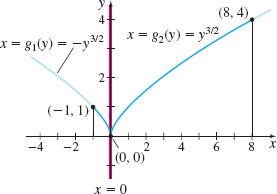EXAMPLE 3Finding the Arc Length of a Function
Find the arc length of f(x)=x2/3 from x=−1 to x=8.
Solution Since the derivative f′(x)=23x1/3 does not exist at x=0, we cannot use the arc length formula (1) to find the length of the graph from x=−1 to x=8.
442
From Figure 52, we observe that the length of the graph of f from x=−1 to x=8 is the same as the length of the graph of x=g1(y)=−y3/2 from y=0 to y=1 plus the length of the graph of x=g2(y)=y3/2 from y=0 to y=4.

We investigate x=g1(y)=−y3/2 first. Since g′1(y)=−32y1/2 is continuous for all y≥0. we can use arc length formula (2) to find the arc length s1 of g1 from y=0 to y=1. s1=∫10√1+[g′1(y)]2dy=↑g′1(y)=−32y1/2∫10√1+(32y1/2)2 dy=∫10√1+94y dy=12∫10√4+9y dy
We use the substitution u=4+9y. Then du=9 dy or, equivalently, dy=du9. The limits of integration are u=4 when y=0, and u=13 when y=1. s1=12∫134√u du9=118[u3/232]134=127(13√13−8)
Now we investigate x=g2(y). Since g′2(y)=32y1/2 is continuous for all y≥0, we can use arc length formula (2) to find the arc length s2 of g2 from y=0 to y=4. s2=∫40√1+[g′2(y)]2 dy=∫40√1+(32y1/2) 2 dy=∫40√1+94y dy=12∫40√4+9y dyLet u=4+9y; du=9dy.=12∫404√u du9=118[u3/232]404=127(80√10−8)
The arc length s of y=f(x)=x2/3 from x=−1 to x=8 is the sum s=s1+s2=127(13√13−8)+127(80√10−8)=127(80√10+13√13−16)